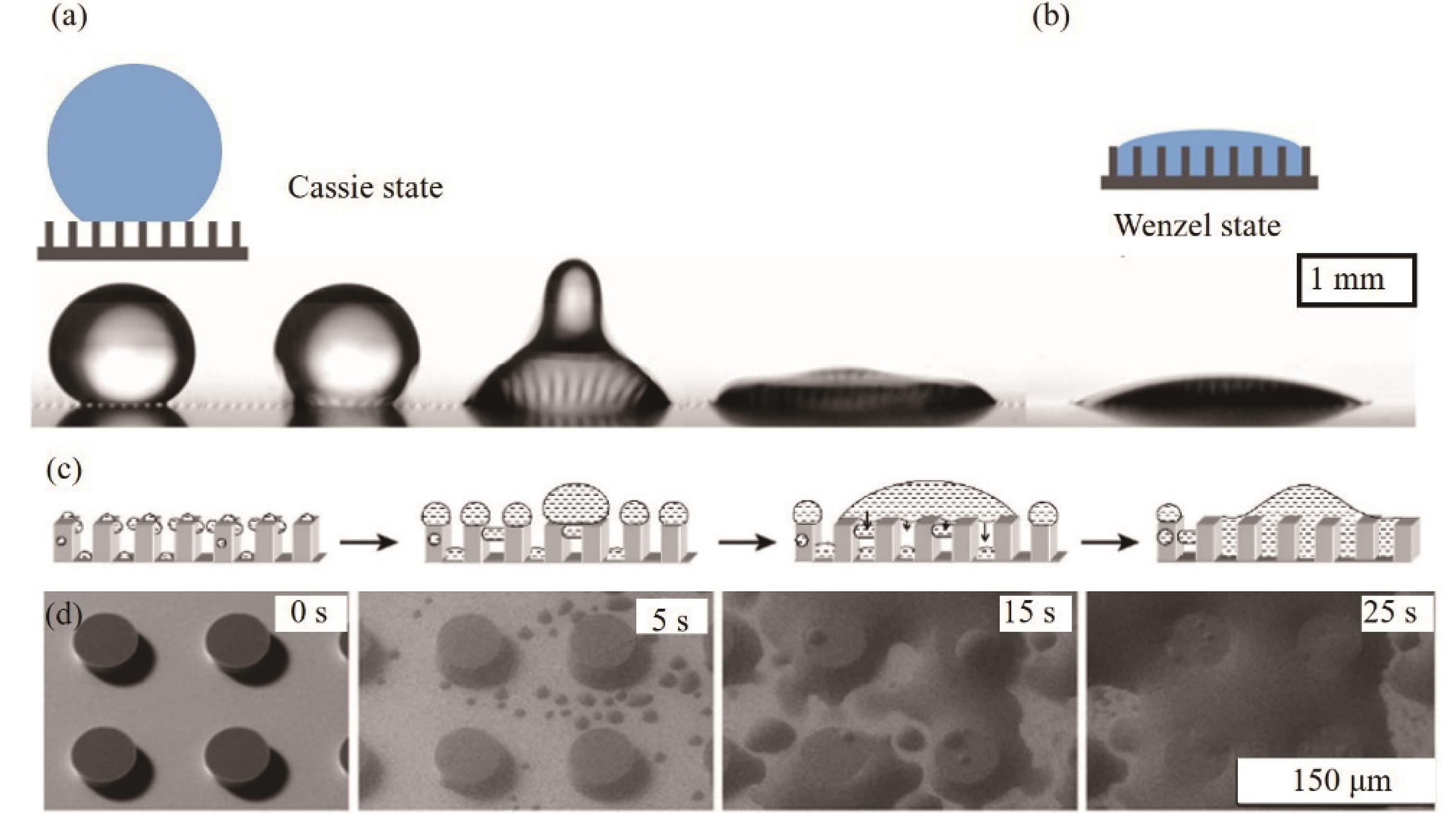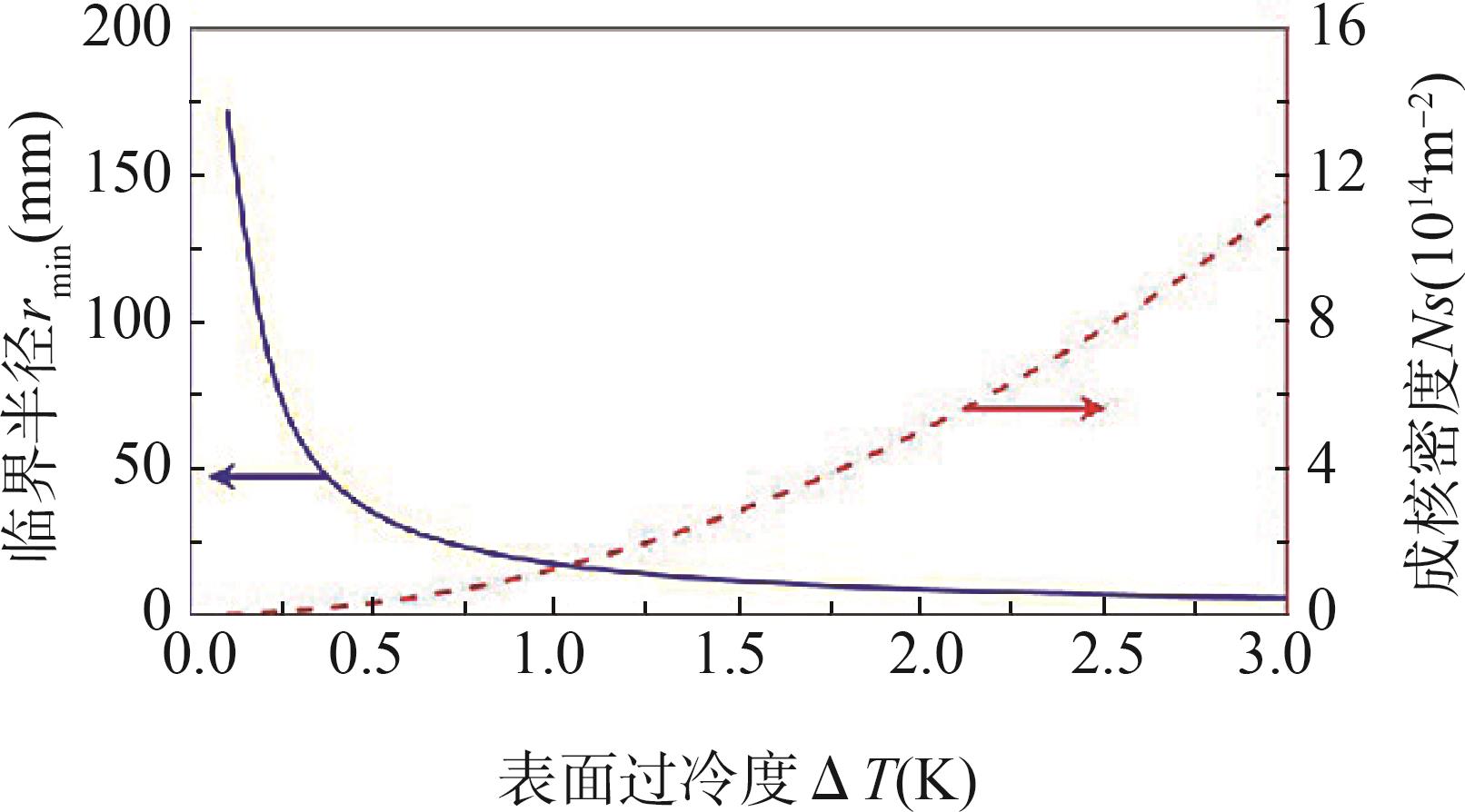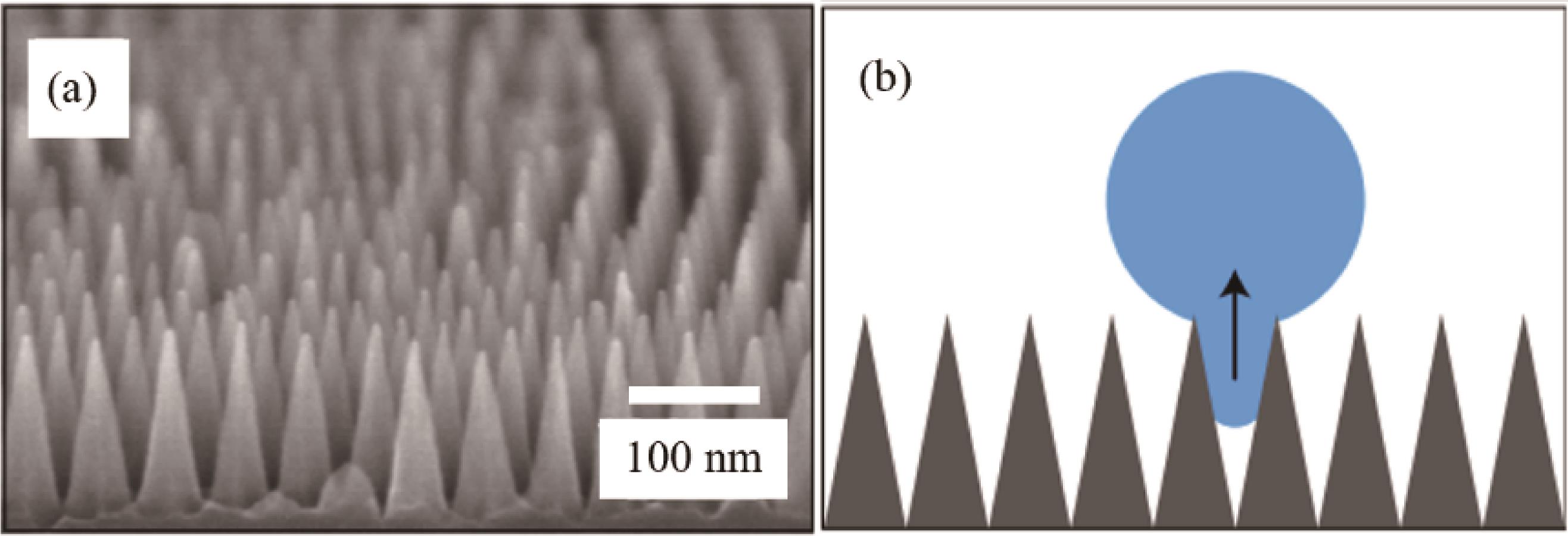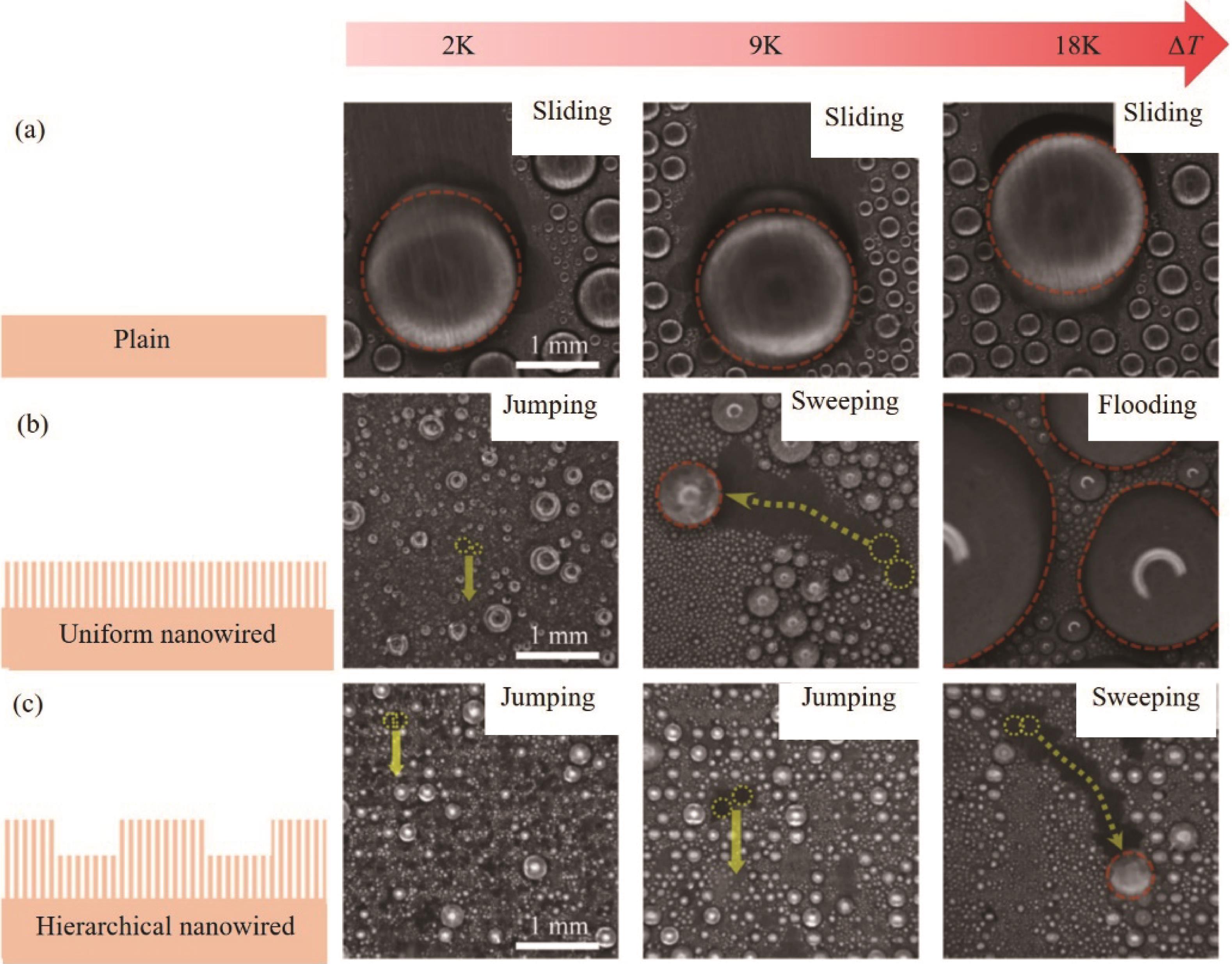
应用化学 ›› 2022, Vol. 39 ›› Issue (1): 142-153.DOI: 10.19894/j.issn.1000-0518.210486
仿生超疏水表面的抗冷凝失效研究进展
- 1.电子科技大学长三角研究院,湖州 313000
2.电子科技大学基础与前沿研究院,成都 610054
-
收稿日期:2021-09-30接受日期:2021-11-01出版日期:2022-01-01发布日期:2022-01-10 -
通讯作者:王德辉 -
基金资助:国家自然科学基金(22072014);四川省杰出青年科技人才项目(2021JDJQ0013);四川省科技计划项目(2021JDRC0016);成都市国际科技合作重点项目(2021-GH02-00105-HZ)
Research Progress on Condensation⁃Induced Invalid of Super⁃hydrophobicity
ZHANG Wen-Jing1,WANG De-Hui1,2( ),DENG Xu2
),DENG Xu2
- 1.Yangtze Delta Region Institute of University of Electronic Science and Technology of China,Huzhou 313000,China
2.Institute of Fundamental and Frontier Sciences,University of Electronic Science and Technology,Chengdu 610054,China
-
Received:2021-09-30Accepted:2021-11-01Published:2022-01-01Online:2022-01-10 -
Contact:De-Hui WANG -
About author:wangdehui@uestc.edu.cn
-
Supported by:the National Natural Science Foundation of China(22072014);the Program for Scientific?Technical Young Talents of Sichuan(2021JDJQ0013);Sichuan Science and Technology Program(2021JDRC0016);the Key Projects in International Science & Technology Cooperation Program of Chengdu, Sichuan(2021?GH02?00105?HZ)
摘要:
在存在一定过冷度或蒸汽过饱和度的条件下,水蒸汽可在固体表面凝结成核。随着过冷度增大,液滴成核半径将随之减小,冷凝液滴的生长融合将无法避免地发生在超疏水表面不可或缺的微/纳米结构内。若液滴不能及时排出,则会滞留在表面结构内并挤出空气,形成局部浸润,导致材料表面的超疏水性能下降或失效,甚至引起泛洪。本文首先总结了表面因冷凝诱导超疏水性失效的机制,并分析了解决该问题存在的难点。随后对近年来通过微/纳结构优化、提高成核空间选择性和外部能量输入3类方法提升表面抗冷凝失效性能的研究进展进行了总结。尽管上述方法使表面的抗冷凝失效能力获得一定程度的提高,但在面对高过冷度、持续冷凝等较为苛刻的环境时,仍然无法保证表面浸润性的长效稳定。因此,超疏水表面因冷凝诱导润湿性转变的问题成为限制其广泛实际应用的关键难题。
中图分类号:
引用本文
张文婧, 王德辉, 邓旭. 仿生超疏水表面的抗冷凝失效研究进展[J]. 应用化学, 2022, 39(1): 142-153.
ZHANG Wen-Jing, WANG De-Hui, DENG Xu . Research Progress on Condensation⁃Induced Invalid of Super⁃hydrophobicity[J]. Chinese Journal of Applied Chemistry, 2022, 39(1): 142-153.

图3 微米柱结构表面的蒸汽冷凝的ESEM图[57]
Fig.3 ESEM images of the condensation of water vapor on a superhydrophobic surface comprising of an array of hydrophobic square posts. (a) Dry surface. (b-c) Snapshot images of the condensation phenomenon on the surface[57]
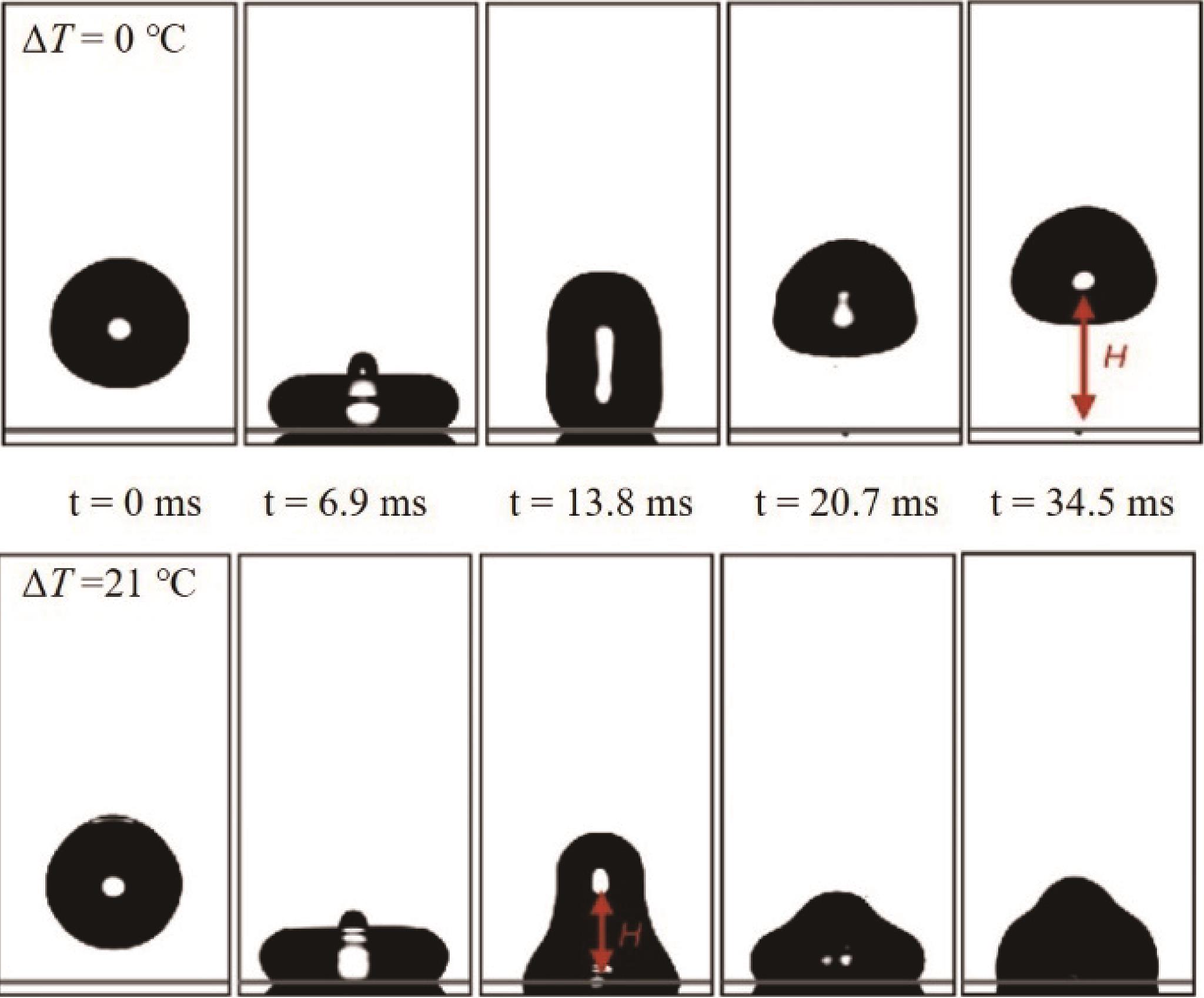
图4 水滴撞击具有不同过冷度的超疏水材料表面[60]
Fig.4 Sequential images of the dynamic behaviors of a water droplet impacting superhydrophobic surfaces with various supercooling degrees[60]
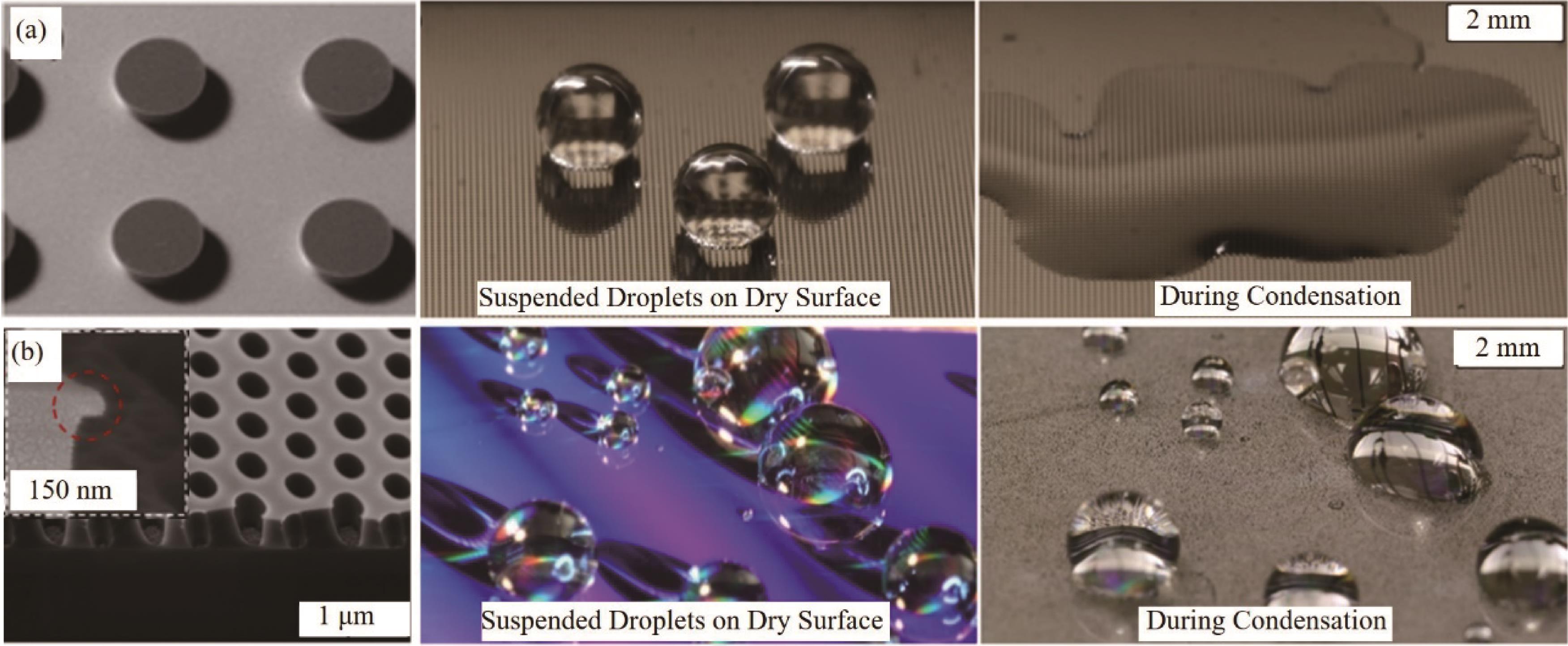
图5 “蘑菇”状微米柱(a)及封闭内凹柱状结构(b)表面的SEM图及水滴在干燥、冷凝表面的润湿状态[48]
Fig.5 SEM images, and water droplets on the surface of mushroom (a), and re-entrant pillar (b) for dry and condensation conditions[48]
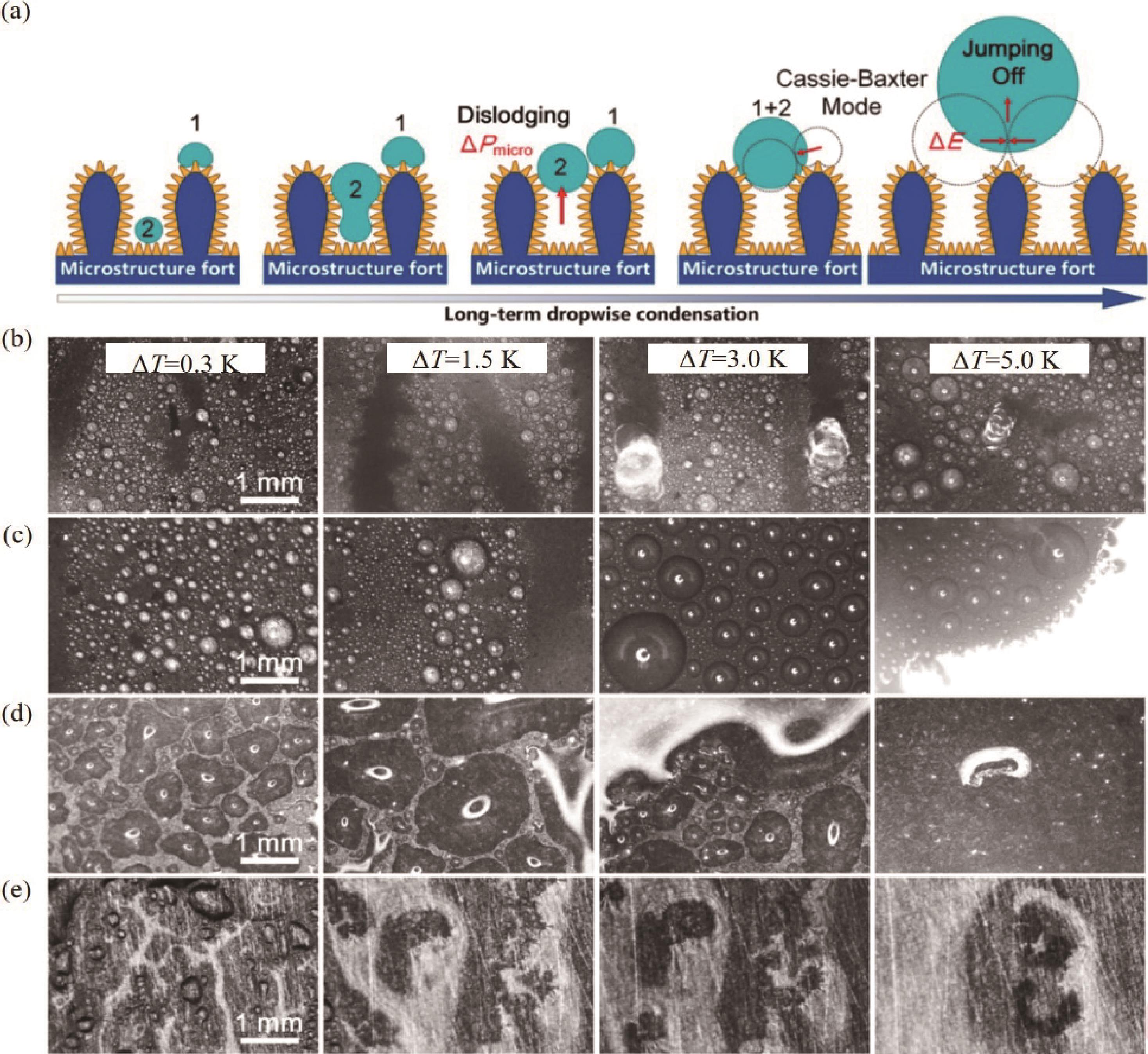
图8 (a) 冷凝液滴从成核到离开表面的全过程;(b - e) 微/纳复合结构、纳米结构、微米结构及光滑铜表面上不同过冷度下材料表面的冷凝[68]
Fig.8 (a) Dropwise condensation and schematics of long-term dropwise condensation on the surface; (b - e) Images of condensated droplets on four types of surfaces at different subcooling, including MNSS, NGSS, MPSS, and Cu[68]
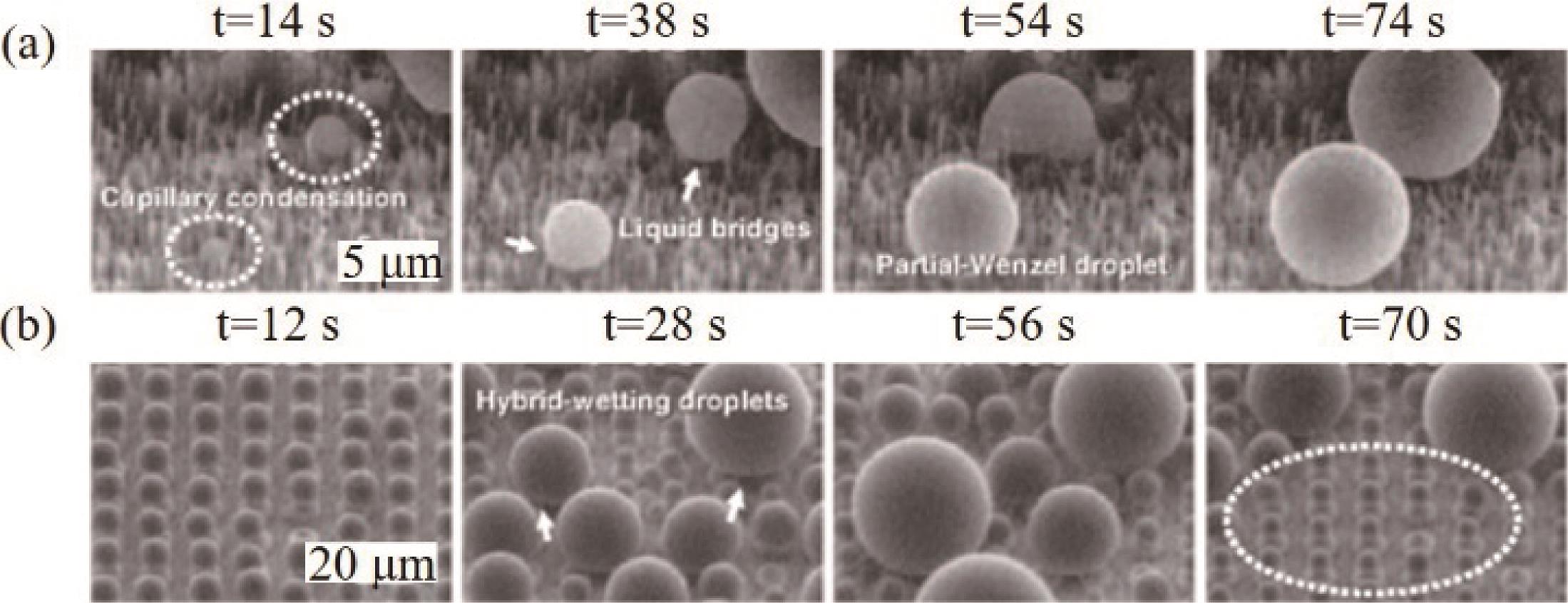
图9 (a)普通超疏水纳米线表面冷凝的ESEM图及(b)亲-疏水复合表面冷凝的ESEM图[69]
Fig.9 ESEM snapshots showing the formation of droplets on superhydrophobic nanograss (a) and biphilic surface (b)[69]
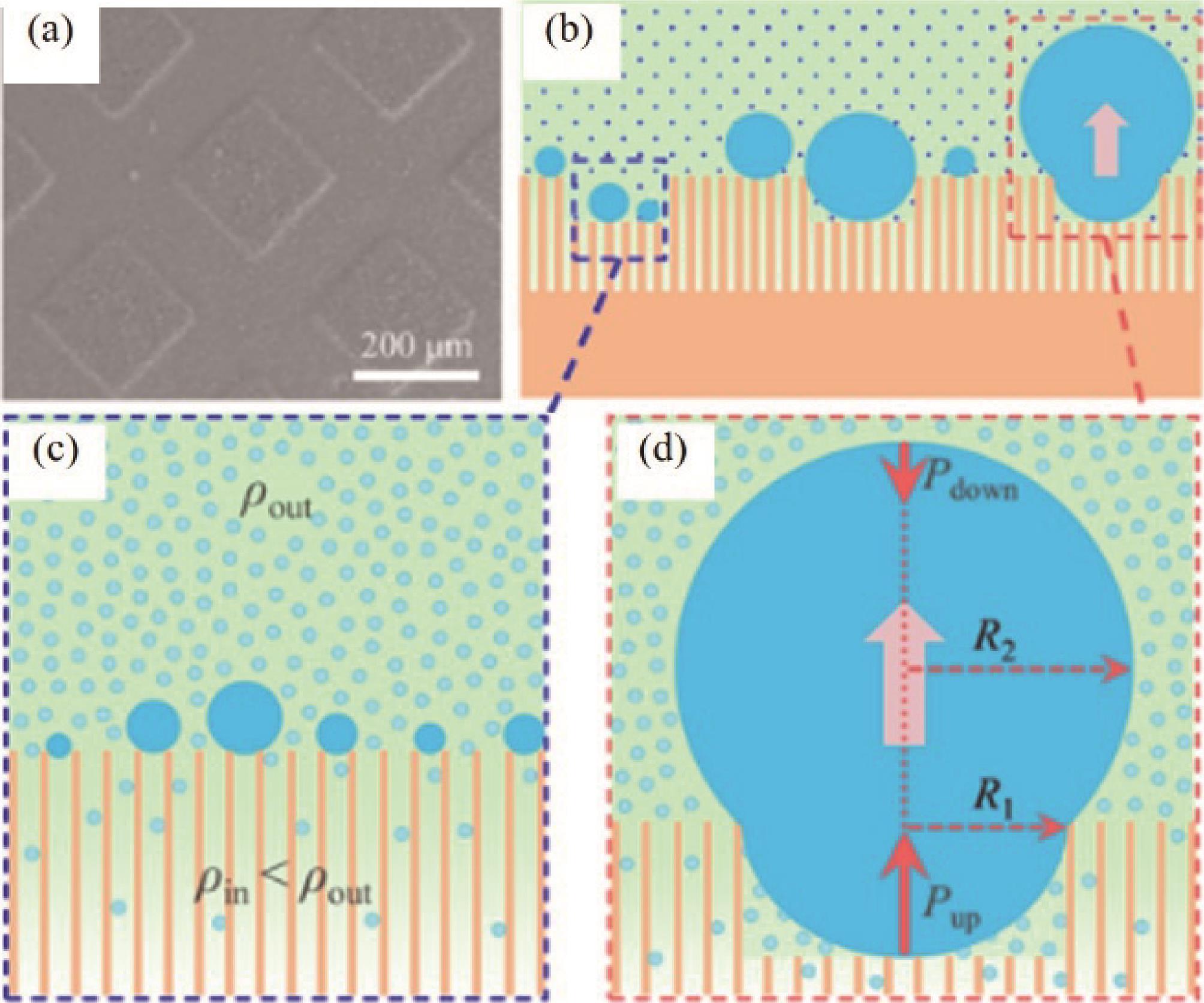
图10 多层纳米线表面SEM图(a)以及其表面的液滴成核及向上移动示意图(b - d)[39]
Fig.10 (a) SEM images of hierarchical nanowiresand (b - d) schematic showing the nucleation and movement of the droplets[39]
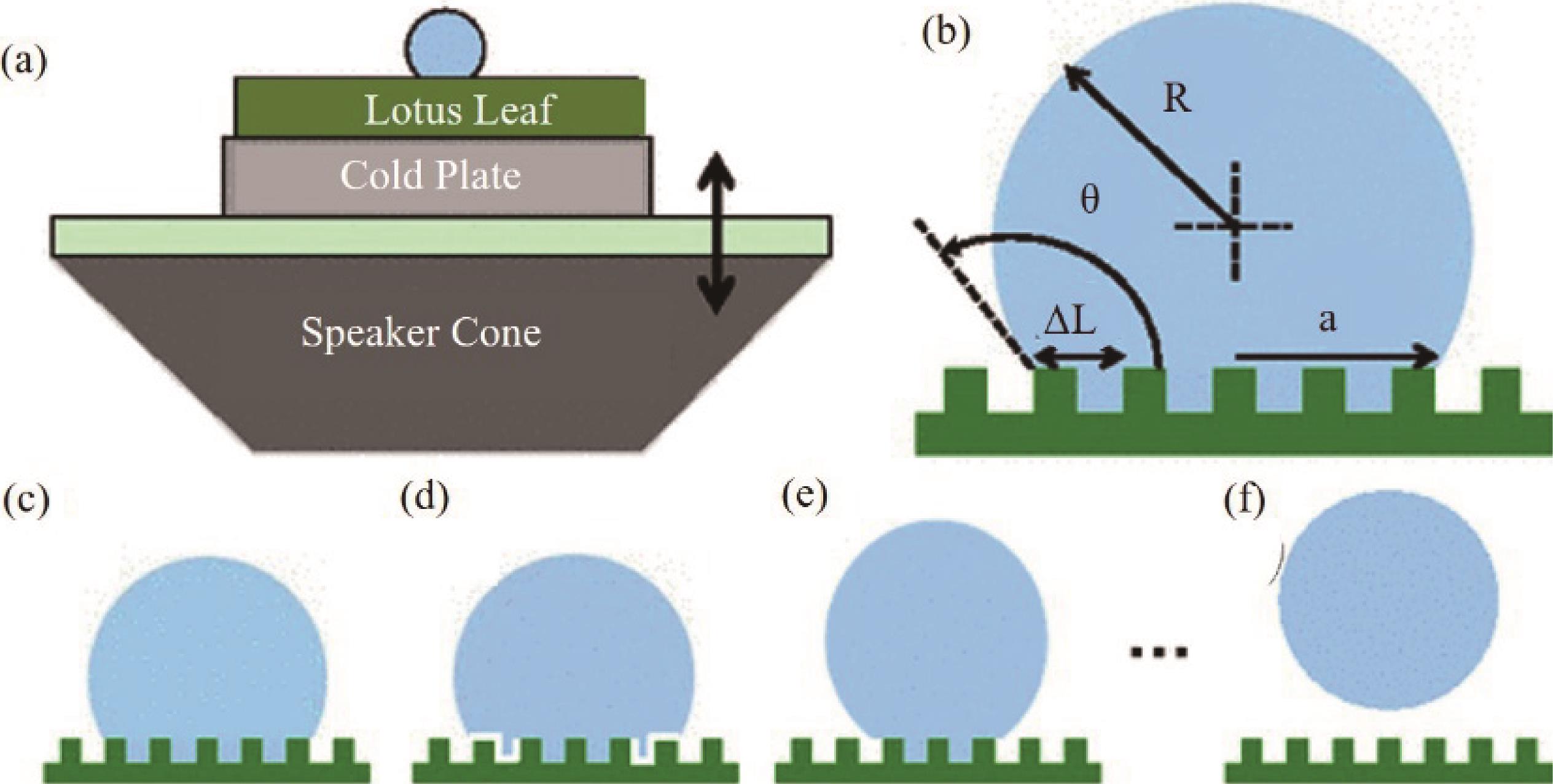
图12 (a)实验装置示意图;(b)液滴在固体表面上的各参数及(c - f) 液滴在外力做用下由Wenzel态向Cassie态的转变[70]
Fig.12 (a) Experimental setup where the cold plate was used only for the condensation experiments; (b) Parameters of the drop used in the model; (c - f) A hypothetical route for the gradual de-wetting during a Wenzel to Cassie transition[70]
| 1 | HENSEL R, NEINHUIS C, WERNER C. The springtail cuticle as a blueprint for omniphobic surfaces[J]. Chem Soc Rev, 2016, 45(2): 323-341. |
| 2 | KOCH K, BHUSHAN B, BARTHLOTT W. Multifunctional surface structures of plants: an inspiration for biomimetics[J]. Prog Mater Sci, 2009, 54(2): 137-178. |
| 3 | FENG L, LI S, LI Y, et al. Super-hydrophobic surfaces: from natural to artificial[J]. Adv Mater, 2002, 14(24): 1857-1860. |
| 4 | LIU K, JIANG L. Bio-inspired self-cleaning surfaces[J]. Annu Rev Mater Res, 2012, 42(1): 231-263. |
| 5 | LIU M, WANG S, JIANG L. Nature-inspired superwettability systems[J]. Nat Rev Mater, 2017, 2(7): 17036(1-17). |
| 6 | LIU M, WANG S, WEI Z, et al. Bioinspired design of a superoleophobic and low adhesive water/solid interface[J]. Adv Mater, 2009, 21(6): 665-669. |
| 7 | ZHAO Y, YU C, LAN H, et al. Improved interfacial floatability of superhydrophobic/superhydrophilic Janus sheet inspired by lotus leaf[J]. Adv Funct Mater, 2017, 27(27): 1701466. |
| 8 | WANG S, LIU K, YAO X, et al. Bioinspired surfaces with superwettability: new insight on theory, design, and applications[J]. Chem Rev, 2015, 115(16): 8230-8293. |
| 9 | BARTHLOTT W, NEINHUIS C. Purity of the sacred lotus, or escape from contamination in biological surfaces[J]. Planta, 1997, 202(1): 1-8. |
| 10 | NEINHUIS C B W. Characterization and distribution of water-repellent, self-cleaning plant surfaces[J]. Annu Botany, 1997, 79(6): 667-677. |
| 11 | QUÉRÉ D. Wetting and roughness[J]. Annu Rev Mater Res, 2008, 38(1): 71-99. |
| 12 | GEYER F, D'ACUNZI M, AGHILI A, et al. When and how self-cleaning of superhydrophobic surfaces works[J]. Sci Adv, 2020, 6(3): 9727. |
| 13 | LIANG Z, ZHOU Z, ZHAO L, et al. Fabrication of transparent, durable and self-cleaning superhydrophobic coatings for solar cells[J]. New J Chem, 2020, 44(34): 14481-14489. |
| 14 | CAO M, GUO D, YU C, et al. Water-repellent properties of superhydrophobic and lubricant-infused “slippery” surfaces: a brief study on the functions and applications[J]. ACS Appl Mater Interfaces, 2016, 8(6): 3615-3623. |
| 15 | CHI F, LIU D, WU H, et al. Mechanically robust and self-cleaning antireflection coatings from nanoscale binding of hydrophobic silica nanoparticles[J]. Solar Energy Mater Solar Cells, 2019, 200: 109939. |
| 16 | CAO Y, SALVINI A, CAMAITI M. One-step fabrication of robust and durable superamphiphobic, self-cleaning surface for outdoor and in situ application on building substrates[J]. J Colloid Interface Sci, 2021, 591: 239-252. |
| 17 | ZHU J, WU J. One-step fabrication of an anti-corrosion superhydrophobic surface on stainless steel[J]. Mater Res Express, 2020, 7(7): 076404. |
| 18 | HE S, SHI J, HUANG J, et al. Rational designed structured superhydrophobic iron oxide surface towards sustainable anti-corrosion and self-cleaning[J]. Chem Eng J, 2021, 416: 127768. |
| 19 | XIN G, WU C, LIU W, et al. Anti-corrosion superhydrophobic surfaces of Al alloy based on micro-protrusion array structure fabricated by laser direct writing[J]. J Alloys Compd, 2021, 881: 160649. |
| 20 | CHEN J, LIU Y, GUO D, et al. Under-water unidirectional air penetration via a Janus mesh[J]. Chem Commun (Camb), 2015, 51(59): 11872-11875. |
| 21 | LEE C, KIM C J. Underwater restoration and retention of gases on superhydrophobic surfaces for drag reduction[J]. Phys Rev Lett, 2011, 106(1): 014502. |
| 22 | XUE Z, CAO Y, LIU N, et al. Special wettable materials for oil/water separation[J]. J Mater Chem A, 2014, 2(8): 2445-2460. |
| 23 | WANG B, LIANG W, GUO Z, et al. Biomimetic super-lyophobic and super-lyophilic materials applied for oil/water separation: a new strategy beyond nature[J]. Chem Soc Rev, 2015, 44(1): 336-361. |
| 24 | MA Q, CHENG H, FANE A G, et al. Recent development of advanced materials with special wettability for selective oil/water separation [J]. Small, 2016, 12(16): 2186-2202. |
| 25 | TANG X, ZHU P, TIAN Y, et al. Mechano-regulated surface for manipulating liquid droplets[J]. Nat Commun, 2017, 8: 14831. |
| 26 | SUN Q, WANG D, LI Y, et al. Surface charge printing for programmed droplet transport[J]. Nat Mater, 2019, 18(9): 936-941. |
| 27 | DAI H, GAO C, SUN J, et al. Controllable high-speed electrostatic manipulation of water droplets on a superhydrophobic surface[J]. Adv Mater, 2019, 31(43): 1905449. |
| 28 | TU Y, WANG R, ZHANG Y, et al. Progress and expectation of atmospheric water harvesting[J]. Joule, 2018, 2(8): 1452-1475. |
| 29 | LI J, ZHU J, GAO X. Bio-inspired high-performance antireflection and antifogging polymer films[J]. Small, 2014, 10(13): 2578-2582. |
| 30 | MOUTERDE T, LEHOUCQ G, XAVIER S, et al. Antifogging abilities of model nanotextures[J]. Nat Mater, 2017, 16(6): 658-663. |
| 31 | HOU W, SHEN Y, TAO J, et al. Anti-icing performance of the superhydrophobic surface with micro-cubic array structures fabricated by plasma etching[J]. Colloids Surf A, 2020, 586: 124180. |
| 32 | QI Y, YANG Z, CHEN T, et al. Fabrication of superhydrophobic surface with desirable anti-icing performance based on micro/nano-structures and organosilane groups[J]. Appl Surf Sci, 2020, 501: 144165. |
| 33 | ZHU T, CHENG Y, HUANG J, et al. A transparent superhydrophobic coating with mechanochemical robustness for anti-icing, photocatalysis and self-cleaning[J]. Chem Eng J, 2020, 399: 125746. |
| 34 | SHEN Y, XIE X, XIE Y, et al. Statistically understanding the roles of nanostructure features in interfacial ice nucleation for enhancing icing delay performance[J]. Phys Chem Chem Phys, 2019, 21(36): 19785-19794. |
| 35 | BARTHWAL S, LIM S H. Rapid fabrication of a dual-scale micro-nanostructured superhydrophobic aluminum surface with delayed condensation and ice formation properties[J]. Soft Matter, 2019, 15(39): 7945-7955. |
| 36 | WANG L, GONG Q, ZHAN S, et al. Robust anti-icing performance of a flexible superhydrophobic surface[J]. Adv Mater, 2016, 28(35): 7729-7735. |
| 37 | HOU Y, YU M, SHANG Y, et al. Suppressing ice nucleation of supercooled condensate with biphilic topography[J]. Phys Rev Lett, 2018, 120(7): 075902. |
| 38 | YANG S, WU C, ZHAO G, et al. Condensation frosting and passive anti-frosting[J]. Cell Rep Phys Sci, 2021, 2(7): 100474. |
| 39 | WEN R, XU S, ZHAO D, et al. Hierarchical superhydrophobic surfaces with micropatterned nanowire arrays for high-efficiency jumping droplet condensation[J]. ACS Appl Mater Interfaces, 2017, 9(51): 44911-44921. |
| 40 | MILJKOVIC N, ENRIGHT R, WANG E. Effect of droplet morphology on growth dynamics and heat transfer during condensation on superhydrophobic nanostructured surfaces[J]. ACS Nano, 2012, 6(2): 1776-1785. |
| 41 | LAN Z, CHEN Y, HU S, et al. Droplet regulation and dropwise condensation heat transfer enhancement on hydrophobic-superhydrophobic hybrid surfaces[J]. Heat Transfer Eng, 2017, 39(17-18): 1540-1551. |
| 42 | WEN R, XU S, MA X, et al. Three-dimensional superhydrophobic nanowire networks for enhancing condensation heat transfer[J]. Joule, 2018, 2(2): 269-279. |
| 43 | LIU Y, CHOI C H. Condensation-induced wetting state and contact angle hysteresis on superhydrophobic lotus leaves[J]. Colloid Polym Sci, 2012, 291(2): 437-445. |
| 44 | SONG Z, LU M, CHEN X. Investigation of dropwise condensation heat transfer on laser-ablated superhydrophobic/hydrophilic hybrid copper surfaces[J]. ACS Omega, 2020, 5(37): 23588-23595. |
| 45 | ZHU Y, TSO C Y, HO T C, et al. Heat transfer enhancement on tube surfaces with biphilic nanomorphology[J]. Appl Therm Eng, 2020, 180: 115778. |
| 46 | ENSIKAT H J, DITSCHE-KURU P, NEINHUIS C, et al. Superhydrophobicity in perfection: the outstanding properties of the lotus leaf[J]. Beilstein J Nanotechnol, 2011, 2: 152-161. |
| 47 | R. D. NARHE D A B. Growth dynamics of water drops on a square-pattern rough hydrophobic surface[J]. Langmuir, 2007, 23: 6486-6489. |
| 48 | WILKE K L, PRESTON D J, LU Z, et al. Toward condensation-resistant omniphobic surfaces[J]. ACS Nano, 2018, 12(11): 11013-11021. |
| 49 | LIU T Q, SUN W, LI X Q, et al. Growth modes of condensates on nanotextured surfaces and mechanism of partially wetted droplet formation[J]. Acta Phys-Chim Sin, 2013, 29(8): 1762-1770. |
| 50 | FENG J, PANG Y, QIN Z, et al. Why condensate drops can spontaneously move away on some superhydrophobic surfaces but not on others[J]. ACS Appl Mater Interfaces, 2012, 4(12): 6618-6625. |
| 51 | CHENG Y T, RODAK D E. Is the lotus leaf superhydrophobic?[J]. Appl Phys Lett, 2005, 86(14): 144101. |
| 52 | SEO D, LEE C, NAM Y. Influence of geometric patterns of microstructured superhydrophobic surfaces on water-harvesting performance via dewing[J]. Langmuir, 2014, 30(51): 15468-15476. |
| 53 | YOUNG T. An essay on the cohesion of fliuds[J]. Philos Trans R S London, 1805, 95: 65-87. |
| 54 | WENZEL R N. Resistance of solid surfaces to wetting by water[J]. Ind Eng Chem, 1936, 28(8): 988-994. |
| 55 | CASSIE A, BAXTER S. Wettability of porous surfaces[J]. Trans Faraday Soc, 1944, 40: 546-51. |
| 56 | WEN R, LAN Z, PENG B, et al. Wetting transition of condensed droplets on nanostructured superhydrophobic surfaces: coordination of surface properties and condensing conditions[J]. ACS Appl Mater Interfaces, 2017, 9(15): 13770-13777. |
| 57 | VARANASI K K, HSU M, BHATE N, et al. Spatial control in the heterogeneous nucleation of water[J]. Appl Phys Lett, 2009, 95(9): 094101. |
| 58 | BROWN R A, ORR F M Jr, SCRIVEN L E. Static drop on an inclined plate analysis by the finite element method[J]. J Collods Interface Sci, 1980, 73(1): 76-87. |
| 59 | EXTRAND C W, GENT A N. Retention of liquid drops by solid surfaces[J]. J Collods Interface Sci, 1990, 138(2): 431-442. |
| 60 | MOUTERDE T, LECOINTRE P, LEHOUCQ G, et al. Two recipes for repelling hot water[J]. Nat Commun, 2019, 10(1): 1410. |
| 61 | PAXSON A T, YAGUE J L, GLEASON K K, et al. Stable dropwise condensation for enhancing heat transfer via the initiated chemical vapor deposition (iCVD) of grafted polymer films[J]. Adv Mater, 2014, 26(3): 418-423. |
| 62 | CHO H J, PRESTON D J, ZHU Y, et al. Nanoengineered materials for liquid-vapour phase-change heat transfer[J]. Nat Rev Mater, 2016, 2(2): 16092. |
| 63 | SHANG Y, HOU Y, YU M, et al. Modeling and optimization of condensation heat transfer at biphilic interface[J]. Int J Heat Mass Transfer, 2018, 122: 117-127. |
| 64 | MILJKOVIC N, ENRIGHT R, NAM Y, et al. Jumping-droplet-enhanced condensation on scalable superhydrophobic nanostructured surfaces[J]. Nano Lett, 2013, 13(1): 179-187. |
| 65 | CHEN X, WU J, MA R, et al. Nanograssed micropyramidal architectures for continuous dropwise condensation[J]. Adv Funct Mater, 2011, 21(24): 4617-4623. |
| 66 | WANG S, LIU M, FENG Y, et al. Bioinspired hierarchical copper oxide surfaces for rapid dropwise condensation[J]. J Mater Chem A, 2017, 5(40): 21422-21428. |
| 67 | ZHAO G, ZOU G, WANG W, et al. Competing effects between condensation and self-removal of water droplets determine antifrosting performance of superhydrophobic surfaces[J]. ACS Appl Mater Interfaces, 2020, 12(6): 7805-7814. |
| 68 | TANG Y, YANG X, LI Y, et al. Robust micro-nanostructured superhydrophobic surfaces for long-term dropwise condensation[J]. Nano Lett, 2021, DOI: 10.1021/acs.nanolett.1c01584. |
| 69 | HOU Y, SHANG Y, YU M, et al. Tunable water harvesting surfaces consisting of biphilic nanoscale topography[J]. ACS Nano, 2018, 12(11): 11022-11030. |
| 70 | BOREYKO J B, CHEN C H. Restoring superhydrophobicity of lotus leaves with vibration-induced dewetting[J]. Phys Rev Lett, 2009, 103(17): 174502. |
| 71 | ZHANG L, SHI J, XU B, et al. Experimental study on distribution characteristics of condensate droplets under ultrasonic vibration[J]. Microgravity Sci Technol, 2018, 30(6): 737-746. |
| 72 | MORADI M, CHINI S F, RAHIMIAN M H. Vibration-enhanced condensation heat transfer on superhydrophobic surfaces: an experimental study[J]. AIP Adv, 2020, 10(9): 095123(1-6). |
| [1] | 任杰, 廖瑞瑞, 杨武, 李岩, 高锦章. 辉光放电电解等离子体处理制备铁基表面超疏水材料[J]. 应用化学, 2013, 30(02): 208-213. |
| 阅读次数 | ||||||
|
全文 |
|
|||||
|
摘要 |
|
|||||
